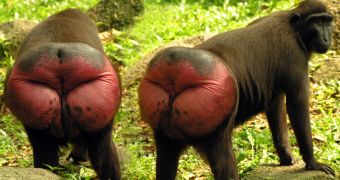Red is hot, but you should know that most mammals do not perceive it. That's why it is a privilege that people and primates can detect it, a gift of the evolution. And soon after getting the ability to perceive red, primates evolved red and orange skin and hair, as shown by a team at Ohio University.
Humans, apes and Old World monkeys, like baboons, vervets, macaques and leaf monkeys, all possess trichromatic vision, so they can make the difference between blue, green and red colors and their combinations. But there is a vivid debate whether primates evolved color vision initially for feeding, enabling them to pick ripe fruit and red leaves among unripe fruits and green foliage, or for mating, with a role in sexual selection.
But the new research discards the mating theory and shows that red-color vision evolved rather for foraging. But once acquired, trichromaticism boosted the evolution of red skin and hair through sexual selection.
The team found a strict correlation of food choice and color vision in Costa Rican howler monkeys and gathered data on the color vision, social and sexual habits and red skin and hair of the current 203 primate species.
A phylogenetic tree of the evolutionary links among all primate species helped to check the order in which red color vision, gregariousness (highly social behavior) and red coloring emerged.
They discovered that the species that could detect red and orange hues were more likely to display red and orange skin (at least in some zones) and hair and to live in large groups, a fact that eased the process of visually comparing mates. In fact, they found that the most sociable trichromats are also the most red (we do not know how this idea sustains the fact that orangutan, the most unsociable ape, is fully red).
"Neuroscience research has found some evidence of a perceptual bias for more brilliant colors. So, it is reasonable for primates with trichromatic color vision to respond more when they see bright colors." said lead author Andre Fernandez, a doctoral student.
"It looks like red skin and hair became a sexual preference. So while the benefits in terms of eating may not apply anymore, the (red-color) vision in some groups is now relevant in social terms." said co-autor Molly Morris, a fish biologist who studies how physical traits such as coloring evolve through sexual selection.
It is known that monkey females signal their fertility period by reddening their buttock pads and some monkeys have sexual signaling red skin patches, like Gelada monkeys (from Ethiopia) on their chests or the noses of the Mandrills (from central Africa).
The red heads of the uakari monkeys (South America) signal their sexual quality.

 14 DAY TRIAL //
14 DAY TRIAL //